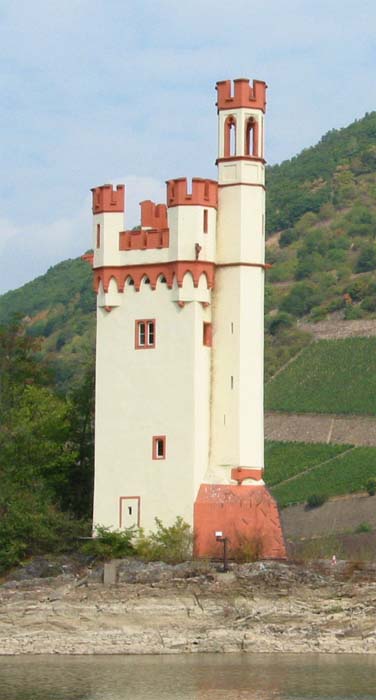

As early as in roman times this tower was built at the "Binger Loch" where the river Rhine has dug it's path through the low mountainous area. The river becomes narrow at this place which makes it ideal for toll-towers and the likes.
After the romans left in the 5th century the tower was handed into the hands of the Franks but soon it decayed to a ruin.
In 968 A.D. Archbishop Hatto II had it reconstructed as a small water-castle on the little island. He spent a lot of time there as he often visited Bingen. When he fell ill, probably because of a rodent plague which could not be averted, the rodents attacked him in the room where he lay ill in his bed. Soon after that he died in 970 in Bingen. And so from rumours a horrible story about the tower was born.
It is said that there was a famine in 968 and the population had managed to get access to the corn chambers of Hatto II. He however had the doors locked and burned the building with all the people inside. He called the people inside a plague that had to be extincted, he called them useless corn-mice. But the real mice that had lived in the corn escaped the fire, and now that their food had been burned away they came to the palace and attacked the archbishop. He fled on his horse towards Bingen, but the mice followed him, and so he thought of the island and crossed over to it, but to no avail. The mice swam to the tower and attacked the bishop, eating him alife.
Only after 1298 the tower became important again and was integrated into the toll system of the Burg Ehrenfels.
The tower was used as strategical position in the Thirty Years' War (1618 - 1648) with in varying possession after 1631. Finally it was burned down to ruins in the destructive activities of the french King Ludwig XIV in 1689.
In the 18th century it became obvious that this position would be
advantageous at the dangerous "Binger Loch", where the river was narrow and
could be accessed easily.
In 1734 during the warfare between the Reich and France soldiers built a
guard post there, but the tower decayed further and was soon forgotten.
In 1855 the position of the island in the river became of importance once more, and the ruin was reconstructed as a lighttower for the ships.
Until 1974 it was used in this way, but today the dangerous rocks in the riverbed have all been removed and the tower no longer is needed.